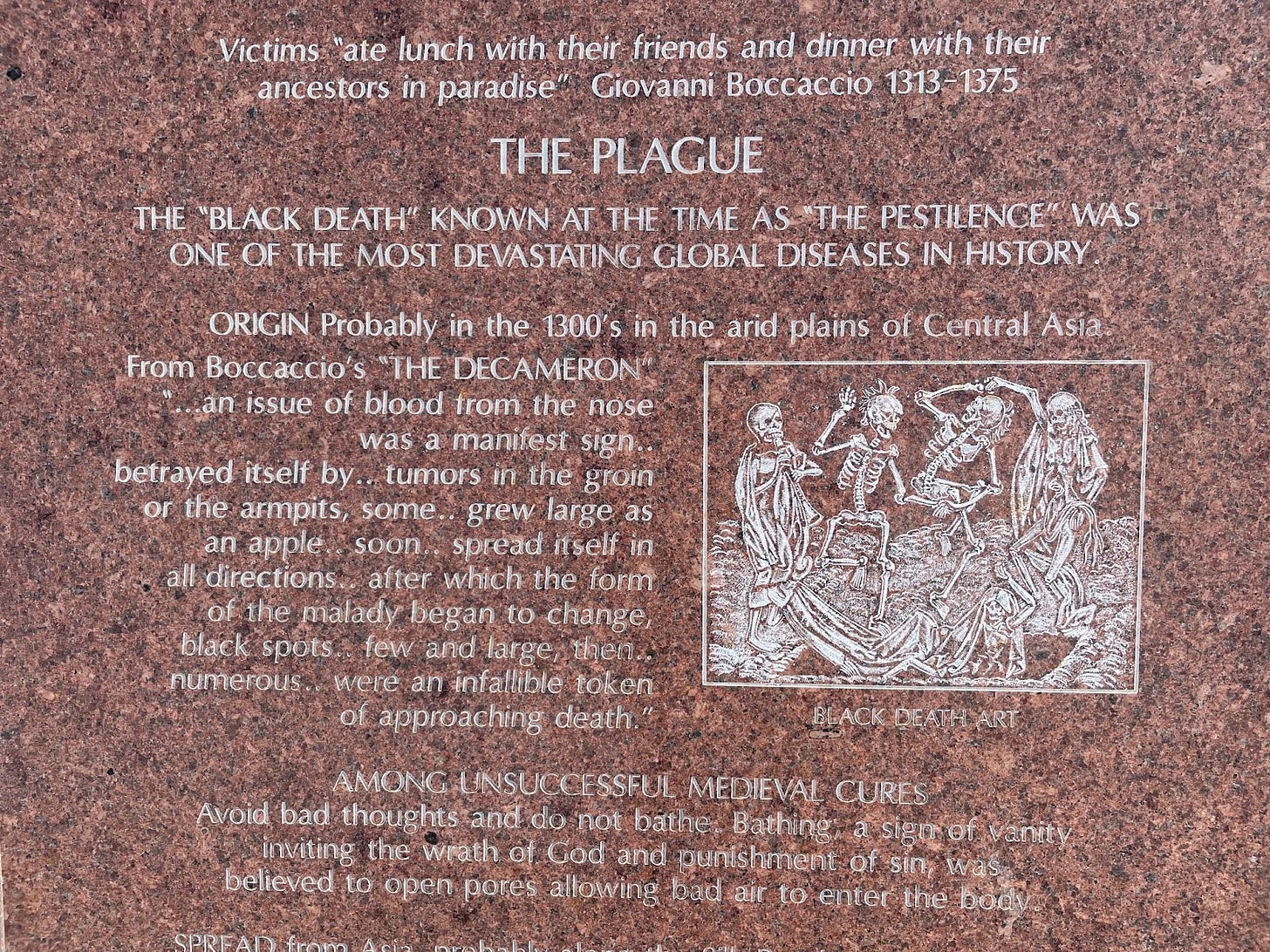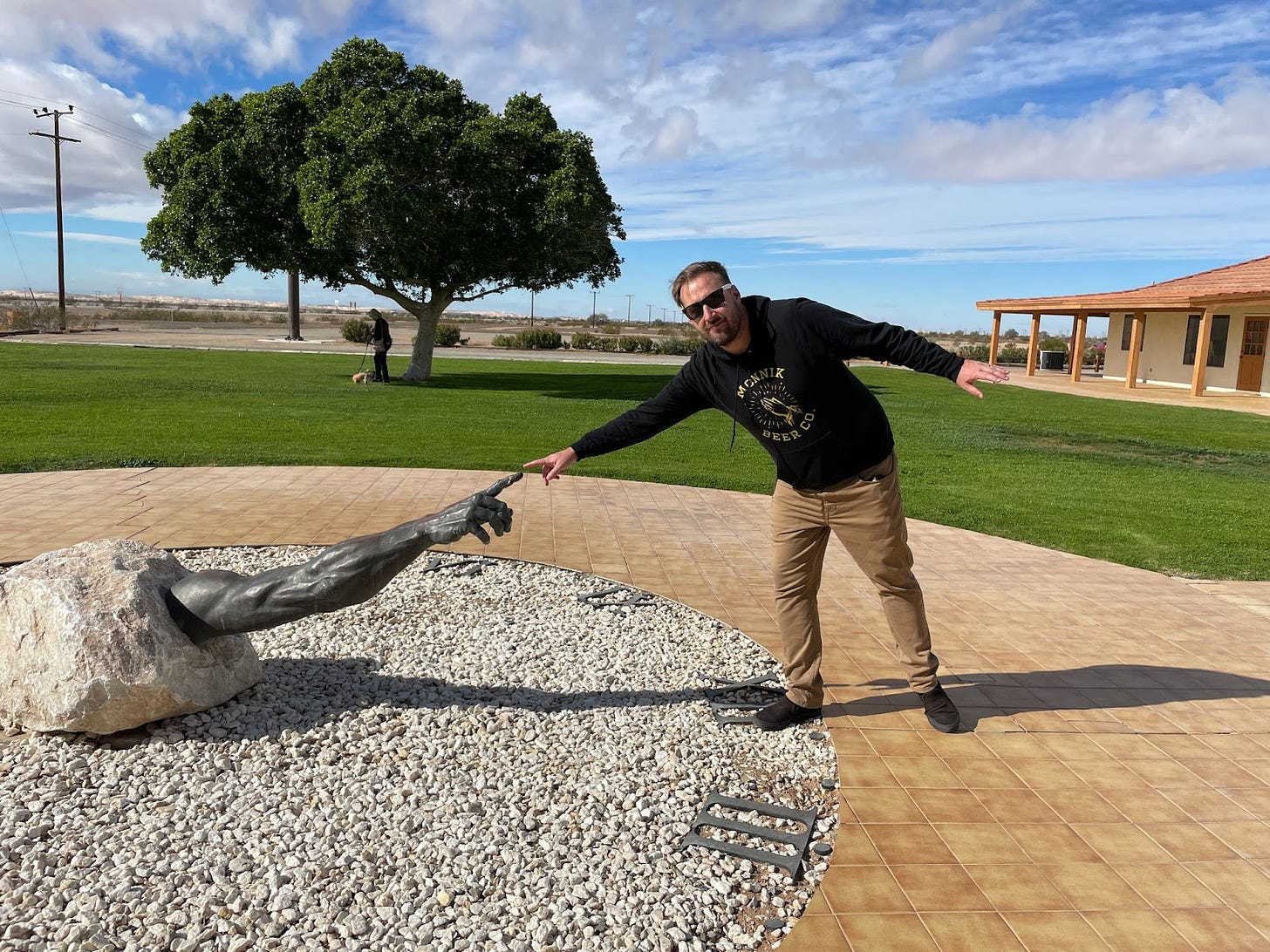The end of the world at The Center of the World
Imperial County roadside attraction is a good post-apocalyptic destination
Perhaps all the sci-fi movies got it wrong. Maybe the end of the world isn’t some far-off date displayed on a screen to let the audience know that—phew—we still have some time. But what if the apocalyptic event has already happened? Let’s see: A plague continues to ravage the land (and probably will for years), we’re meme-ing our way through a war that has already claimed civilian casualties, and extreme weather is making certain parts of the planet increasingly inhospitable. What if the apocalypse already happened and we were too absorbed in our own lives to notice? What if we’re already living in the post-apocalypse?
It’s easy to have these end-of-the-world thoughts when you’re driving through Yuma. The eastern California desert might as well be a Mad Max film.
In an effort to distract myself from doomed thoughts, I open the warm styrofoam container on my lap. Inside lays a breakfast burrito that I picked up from a casino just outside of Yuma.
The burrito weighs as much as a healthy baby, brimming with undercooked potatoes and overcooked bacon. I take a bite. In The Road Warrior, Mad Max eats dog food from a can; I can’t say this burrito is much better. My wife Jessica’s at the wheel and pretends not to notice the smell.
A few miles down the road, a triangular sign appears that reads: “The Center of the World.” We’ve passed this sign so many times on our frequent trips to and from Arizona, but we never stop; the desire to get back to San Diego always kills the curiosity. Plus, has anyone ever left a roadside attraction and felt like they’ve gotten their money’s worth? The mystique is always better than reality.
But now, given the bleakness of the landscape, the turmoil in the world, and the trajectory of my thoughts, Center of the World seems ominously prophetic and profound. When humankind has devolved into traveling bands of gasoline-reeking road pirates—hoarding monkey NFTs and dabbling in light cannibalism—who’s to say The Center of the World couldn’t be the site of a new civilization?
“Let’s stop,” I say, mouth stuffed with garbage burrito.
A sign welcomes us to “Center of the World Plaza” and underneath those words, it reads: “Felicity, California.” The attraction, it seems, is not just a curio for desert travelers, but an actual unincorporated community.
We turn into the gravel parking lot, and each new sight just deepens our awe. Or, like, the opposite of awe. Remember in Jurassic Park when the guests arrive at the park and they gawk in wonder at increasingly unbelievable sights? Center of the World is a little like that, but instead of wonder, it’s confusion. There’s a spiral staircase that leads to nowhere, a giant sundial featuring a gnomon shaped like Sistine Chapel Adam’s arm, and a pyramid made of stone and glass. The whole thing feels like a rich eccentric’s private collection: random, themeless, and expensive. Across from the visitor center, there’s a multi unit apartment building with a sign that says “Apartments for Rent.”
But it’s the church that intrigues me the most.
Rising high above the desert landscape and visible from the highway, a human-made plateau acts like a serving dish for the world’s tiniest, most picturesque church. Even though I’m not religious, the white and blue chapel holds a monolithic—perhaps uncanny—power, like something out of a dream or a surrealist painting. I sometimes refer to the church as “November Rain” because of its resemblance to the Guns ‘n’ Roses video where Slash solos majestically in front of a tiny, middle-of-nowhere chapel.
The merchandise in the visitor center is like if a truck of cheap imports spilled its contents all over the highway and it all bounced into the store. Porcelain cats, overpriced toys and foreign-made paper weights—none of which have any affiliation to the roadside attraction—await every gullible sucker. I imagine the only demographic who shops here are dads who’ve missed their kid’s birthday and need a last-minute gift.
Entrance to the Center of the World costs $5, but for an extra fee of $3, the woman tells us we can go inside the pyramid, which purportedly houses the exact center of the world. “No thank you,” I say. I’m still bitter about the one time I went to the Sideshow at Coney Island and paid extra to see frightening human oddities, which turned out to be very fake mutant fetus toys. “No more getting got at roadside attractions” may not be the most elegant philosophy, but it’s saved me at least a dozen dollars over the past decade.
The elderly woman working behind the counter eyes my styrofoam container with a sour mix of hate and fear. “Do you have a trash can that I can put this in?” I ask the woman, waving my burrito container in the air.
“I’d actually appreciate it if you put that back in your car,” she says. “There’s a dumpster on your way out of town, but it’s a little far to walk there.”
You’re saying there aren’t any trash cans in all of Felicity? I want to ask, but then think better of it. We’re guests here; best to just follow the rules of the Felicitians.
I toss the container back in the car and return to find Jessica alone in a tiled room adjacent to the visitor center. There are two rows of plastic lawn chairs set up in front of a large flatscreen TV connected to a DVD player.
“I got the good seats,” she says.
We watch a video that tries to explain the concept of The Center of the World, but like most everything else around here, it raises more questions than it answers.
Here’s the gist: Felicity was founded by investment banker and famed parachutist Jacques-André Istel. In the ‘80s, he developed the land into the Museum of Granite, which he began as an attempt to commemorate the Korean War by engraving the names of all the casualties onto walls of stone.
Since then, however, there have been many varied histories etched into slabs behind the visitor’s center. It’s almost like Istel found an encyclopedia and said, “This needs to be heavier somehow.”
The video doesn’t go into detail about why someone would create all of this out in the middle of the desert, or why certain histories are chosen to be immortalized. Or why there’s also a pyramid, a church, a sundial and concrete maze on the property. Namely, Felicity or Center of the World or whatever feels like Istel’s desperate attempt to leave a mark on the earth. To prove that he was here. That we were here.
I think there’s comfort in that desire, especially when our world feels more apocalyptic by the day.
When the movie ends, we walk out and explore slabs, which look vaguely like construction barriers. They extend across a plaza that must be the size of two football fields—rows and rows and rows of history etched into rock. This rocks, I think. The granite feeds into the horizon, which is capped by the church on the hill. The sight is simultaneously beautiful and ominous.
I read slab after slab about the history of California. Not going to lie: It reads like something you’d find on a fifth grader’s report on the state, but I guess I haven’t forged any words into stone, so who am I to judge?
I climb the steps to the church. After so much time wondering about it, I’m a little disappointed to realize that the church is just a church. No special exhibit, no wailing guitarist, not even any weird cult shit—just an austere and peaceful chapel. Why does it exist? Do people actually go to services here or is it just meant to lure people in from the highway? And why is it set so far back from the road? Frankly, I’d be pissed if I had to walk so far for church, but I’ve also seen the traffic to get into Rock Church in Point Loma, and maybe this falls pretty low on the inconvenience scale.
From the church’s steps, I look back down on the Museum of Granite. The aerial view is breathtaking. The rows of polished granite shimmer in the desert sun. It’s like a geometric configuration of Wiccan symbols or alien communique or a combination of both. If it’s a message to otherworldly beings, I’m certain they’ll fit right in with the strangeness of Felicity.
After about an hour at The Center of the World, we decide it’s time to hit the road. Before getting back in the car, we walk through the concrete maze, and not gonna lie: it’s super easy. No one’s getting lost in that thing. The maze is by far the least confusing thing about The Center of the World.
As we drive off, I think about Jacques-André Istel, Felicity, and the Center of the World, and determine that if the world really is headed toward extinction, Istel’s project might actually be a good testament to the accomplishments of the human race. Or, if there actually is a post-apocalyptic world as portrayed in Mad Max, The Center of the World would be an ideal Cradle of New Civilization: there’s a spiritual center (November Rain church), a history etched into granite slabs, and a sundial for when the world clocks fail. In fact, Felicity is a paradise for anyone in need of permanence—a rare commodity given the uncertainty that’s been happening in the world over the past few years.
I just hope that if the world does end and a new society springs up in Felicity, they decide to have more than one trash can.
AWKSD GUEST LIST
The Guest List gives AWKSD subscribers the opportunity to see live music for free. Just reply to this email and let me know which show you want to see, and I’ll hook you and a friend up. First come, first served.
Friday, Mar. 11
Lofi Legs, Eclipse, Flower Animals @ Til-Two: Lofi Legs are one one part garage rock, another part flower punk, and a dash of psychedelics. Their songs are just so infectiously joyful and stoned that it’s really hard to feel bad while listening to them. (Also, naming their latest album Leg Day is A+ in my book).
Sunday, Mar. 13
Liza Anne, Julianna Zachariou @ Soda Bar: Considering that Liza Anne’s 2020 album, Bad Vacation, was recorded prior to the pandemic, it’s hard not to see it as some sort of cursed prophecy. Regardless of the “too soon” vibes that title gives off, the album is well worth your attention, because it’s stuffed with folk-pop gems that espouse the importance of mental health. She also gets props from me for adding heavy flourishes of pop-punk throughout.
Got a tip or wanna say hi? Email me at ryancraigbradford@gmail.com, or follow me on Twitter @theryanbradford. And if you like what you’ve just read, please hit that little heart icon at the end of the post.
Julia Dixon Evans edited this post. Thanks, Julia. Go follow her on Twitter.









